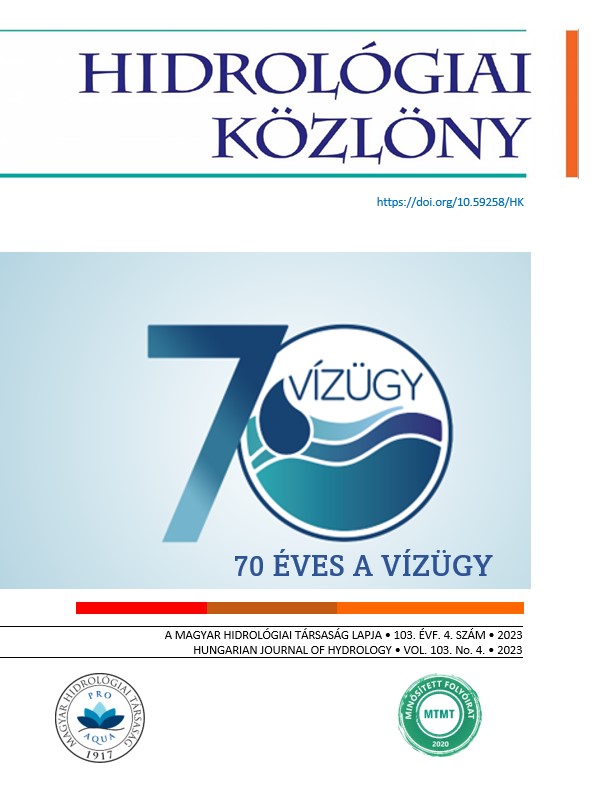A szivárgási tényező jelentősége kavicsbányatavak hatásvizsgálata esetén
Absztrakt
A bányatavak felszínének párolgása a talajvízből pótlódik. Ez a fedett területhez viszonyított többlet a felszín alatti vízmérleg szempontjából veszteség, mely a létesítendő mű környezetében módosuló áramlási viszonyokat és lecsökkenő talajvízszintet eredményez. Ezen vízszintcsökkenés – leszívás – nagyságát a szivárgási tényező alapvetően befolyásolja. A szivárgási tényező a műszaki és a földtani gyakorlat egyik legbizonytalanabbul becsülhető jellemzője, hiszen egy adott bányatelken pontról pontra, vagy rétegről rétegre akár nagyságrendi változások is előfordulhatnak. Eközben igazolható, hogy hatása a tó környékén kialakuló talajvízszintekre jelentős: egy adott talajon belüli szélsőségek a leszívásban akár tízszeres eltérést is okozhatnak. Jelen közlemény célja a szivárgási tényező meghatározására kidolgozott főbb módszerek összefoglalásával, a bányatelkek vizsgálata során leginkább alkalmazható módszerek összevetésével felhívni a figyelmet a paraméter fontosságára.
Hivatkozások
Farkas D., Farkas-Karay Gy., Hegedűs N. (2019). Szivárgási tényező laboratóriumi meghatározása szemel-oszlási görbe és kisminta-modell felhasználásával. Hidrológiai Közlöny, 99. évf. 4. sz. pp. 42-51.
J. F. Devlin Software http://www.people.ku.edu/~jfdevlin/Software.html
Juhász J. (2002). Hidrogeológia. Akadémiai Kiadó, Budapest. p. 1176.
Kammerer, G., Loiskaindl, W. (2008). Bodenphysik. Universität für Bodenkultur Wien.
Kasenow, M. (2002). Determination of hydraulic conductivity from grain size analysis. Water Resources Publications, Highlands Ranch, CO, USA
Kézdi Á., Markó I. (1974). Földművek. Víztelenítés. Műszaki Könyvkiadó, Budapest. p. 298.
Kovács Gy. (1972). A szivárgás hidraulikája. Akadémiai Kiadó, Budapest. p. 535.
Mérnöki Kézikönyv (1981). Mérnöki Kézikönyv 1. kötet. szerk: Palotás L. Műszaki Könyvkiadó, Budapest. p. 926.
Mérnöki Kézikönyv (1957). Mérnöki Kézikönyv 2. kötet, szerk: Palotás L. Műszaki Könyvkiadó, Budapest. p. 1042.
MSZ 15221 (1969). Vízépítés. Szivárgások vizsgálata építményeket határoló talajrétegekben.
Nagy L. (2008a). Finomszemcsés talajok áteresztőképessége. Közúti és Mélyépítési Szemle 58. évf. 5-6. sz. pp. 33-40.
Nagy L. (2008b). Jól graduált talajok áteresztőképességi együtthatója. Közúti és Mélyépítési Szemle 58. évf. 8. sz. pp. 23-27.
Odong, J. (2007). Evaluation of empirical formulae for determination of hydraulic conductivity based on grain-size analysis. Journal of American Science, 3(3). pp. 54-60.
Tompa L. (1982). A kavicsbányászat története Magyarországon. Földtani Kutatás XXV. évf. 2. sz. pp. 69-76.
Varga I., Csoma R. (1995). Környezeti áramlástantan. Felszíni és felszín alatti vízterek. Tanszéki sokszorosí-tású előadási jegyzet. Budapesti Műszaki Egyetem Vízépítési Tanszék
Vienken, Th. (2010). Critical evaluation of vertical high resolution methods for determining hydraulic con-ductivity. Dissertation. Eberhard Karls Universität Tübingen.
Vízrajzi Atlasz 11. kötet (1971). Duna. Vízrajzi Atlasz 11. kötet. Vízgazdálkodási Tudományos Kutató Inté-zet. Budapest.
Vukovic, M., Soro, A. (1992). Determination of hydraulic conductivity of porous media from grain-size com-position. Water Resources Publications, Littleton, Colorado, USA
Copyright (c) 2023 Rózsa Csoma

This work is licensed under a Creative Commons Attribution-NonCommercial-ShareAlike 4.0 International License.




